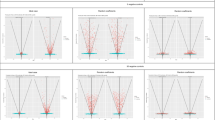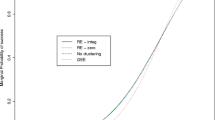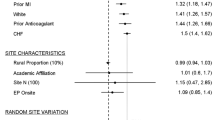Abstract
We study causal inference using the framework of potential outcomes in clustered data settings where observational units are clustered in naturally occurring groups (e.g. patients within hospitals). To incorporate the correlated nature of the data, we employ mixed-effects models and a sandwich estimator to make inferences on the average causal effect (ACE). Our methods apply the concept of potential outcomes from the Rubin Causal Model (Holland in J Am Stat Assoc 81(396):945–960, 1986), and extend Schafer and Kang’s methods of estimating the variance of the ACE (Schafer and Kang in Psychol Methods 13(4):279–313, 2008). Particularly, we develop two model-based approaches to estimate the ACE and its variance under a dual-modeling strategy which adjusts for the confounding effect through inverse probability weighting. These two approaches use linear mixed-effects models for the estimation of potential outcomes, but differ in how clustering is handled in the treatment assignment model. We present a summary of our comprehensive simulation study assessing the repetitive sampling properties of the two approaches in a pseudo-random simulation environment. Finally, we report our findings from an application to study the ACE of inadequate prenatal care on birth weight among low-income women in New York State.

Similar content being viewed by others
References
Austin, P.C.: Balance diagnostics for comparing the distribution of baseline covariates between treatment groups in propensity-score matched samples. Stat. Med. 28(25), 3083–3107 (2009)
Austin, P.C.: An introduction to propensity-score methods for reducing the effects of confounding in observational studies. Multivar. Behav. Res. 46, 399–424 (2011)
Austin, P.C., Stuart, E.A.: Moving towards best practice when using inverse probability of treatment weighting (IPTW) using the propensity score to estimate causal treatment effects in observational studies. Stat. Med. 34(28), 3661–3679 (2015)
Austin, P.C., Mamdani, M.M., Stukel, T.A., Anderson, G.M., Tu, J.V.: The use of the propensity score for estimating treatment effects: administrative versus clinical data. Stat. Med. 24(10), 1563–1578 (2005)
Austin, P.C., Grootendorst, P., Anderson, G.M.: A comparison of the ability of different propensity score models to balance measured variables between treated and untreated subjects: a monte carlo study. Stat. Med. 26(4), 734–753 (2007)
Berg, J.K., Bradshaw, C.P., Jo, B., Lalongo, N.S.: Using complier average causal effect estimation to determine the impacts of the good behavior game preventive intervention on teacher implementers. Adm. Policy Mental Health 44(4), 558–571 (2017)
Buescher, P.A., Smith, C., Holliday, J.L., Levine, R.H.: Source of prenatal care and infant birth weight: the case of a North Carolina county. Am. J. Obstet. Gynecol. 156(1), 204–210 (1987)
Cain, L.E., Cole, S.R.: Inverse probability-of-censoring weights for the correction of time-varying noncompliance in the effect of randomized highly active antiretroviral therapy on incident aids or death. Stat. Med. 28(12), 1725–1738 (2009)
Chan, K.C.: A note about the identifiability of causal effect estimates in randomized trials with non-compliance. Stat. Methodol. 16, 68–71 (2014)
Cheng, J.: Estimation and inference for the causal effect of receiving treatment on a multinomial outcome. Biometrics 65(1), 96–103 (2009a)
Connell, A.M.: Employing complier average causal effect analytic methods to examine effects of randomized encouragement trials. Am. J. Drug Alcohol Abuse 35(4), 253–259 (2009)
Demidenko, E.: Mixed Models Theory Applications. Wiley, New York (2004). ISBN 978-0-471-60161-6
Demirtas, H.: Practical advice on how to impute continuous data when the ultimate interest centers on dichotomized outcomes through pre-specified thresholds. Commun. Stat. Simul. Comput. 36(4), 871–889 (2007)
Donaldson, P.J., Billy, J.O.: The impact of prenatal care on birth weight: evidence from an international data set. Med. Care 22(2), 177–188 (1984)
Elliott, M.R., Raghunathan, T.E., Li, Y.: Bayesian inference for causal mediation effects using principal stratification with dichotomous mediators and outcomes. Biostatistics 11(2), 353–372 (2010)
Frangakis, C.E., Rubin, D.B.: Addressing complications of intention-to-treat analysis in the combined presence of all-or-none treatment non-compliance and subsequent missing outcomes. Biometrika 86(2), 365–379 (1999)
Frangakis, C.E., Rubin, D.B.: Principal stratification in causal inference. Biometrika 58(1), 21–29 (2002)
Gallop, R., Small, D.S., Lin, J.Y., Elliott, M.R., Joffe, M., Ten Have, T.R.: Mediation analysis with principal stratification. Stat. Med. 28(7), 1108–1130 (2009)
Gitelman, A.I.: Estimating causal effects from multilevel group-allocation data. J. Educ. Behav. Stat. 30(4), 397–412 (2005)
Gruber, S., Van Der Laan, M.J.: Consistent causal effect estimation under dual misspecification and implications for confounder selection procedures. Stat. Methods Med. Res. 24(6), 1003–1008 (2015)
Gruber, J.S., Amold, B.F., Reyqadas, F., Hubbard, A.E., Colford Jr., J.M.: Estimation of treatment efficacy with complier average causal effects (CACE) in a randomized stepped wedge trial. Am. J. Epidemiol. 179(9), 1134–1142 (2014)
Hernán, M.A.: A definition of causal effect for epidemiological research. J. Epidemiol. Commun. Health 58(4), 265–271 (2004)
Hernán, M.A., Robins, J.M.: Estimating causal effects from epidemiological data. J. Epidemiol. Commun. Health 60(7), 578–586 (2006)
Hernán, M.A., Brumback, B., Robins, J.M.: Marginal structural models to estimate the joint causal effect of non-randomized treatments. J. Am. Stat. Assoc. 96(454), 440–448 (2001)
Hernán, M.A., Brumback, B., Robins, J.M.: Estimating the causal effect of zidovudine on CD4 count with a marginal structural model for repeated measures. Stat. Med. 21(12), 1689–1709 (2002)
Ho, D.E., Lmai, K., King, G., Stuart, E.A.: Matching as nonparametric preprocessing for reducing model dependence in parametric causal inference. Polit. Anal. 15(3), 199–236 (2007)
Holland, P.W.: Statistics and causal inference. J. Am. Stat. Assoc. 81(396), 945–960 (1986)
Hueston, W.J.: Prenatal care and low-birth-weight rates in urban and rural Wisconsin. J. Am. Board Fam. Med. 8(1), 17–21 (1995)
Jamieson, D.J., Buescher, P.A.: The effect of family planning participation on prenatal care use and low birth weight. Fam. Plan. Perspect. 24(5), 214–218 (1992)
Kang, J.D., Schafer, J.L.: Demystifying double robustness: a comparison of alternative strategies for estimating a population mean from incomplete data. Stat. Sci. 22(4), 523–539 (2007)
Kessner, D.M., Singer, J., Kalk, C.E., Schlesinger, E.R.: Infant Death: An Analysis by Matemal Risk and Health Care. Institute of Medicine and National Academy of Sciences, Washington, DC (1973)
Leon, A.C., Demirtas, H., Li, C., Hedeker, D.: Two propensity score-based strategies for a three decade observational study: investigating psychotropic medications and suicide risk. Stat. Med. 31(27), 3255–3260 (2012a)
Leon, A.C., Hedeker, D., Li, C., Demirtas, H.: Performance of a propensity score adjustment in longitudinal studies with covariate-dependent representation. Stat. Med. 31(20), 2262–2274 (2012b)
Loftus, C.T., Stewart, O.T., Hensley, M.D., Enquobahrie, D.A., Hawes, S.E.: A longitudinal study of changes in prenatal care utilization between first and second births and low birth weight. Matern. Child Health J. 19(12), 2627–2635 (2015)
Neyman, J.: On the application of probability theory to agricultural experiments. Essay on principles. Section 9. Stat. Sci. 5(4), 465–472 (1923)
Pearl, J.: Causality: Models, Reasoning, and Inference, 2nd edn. Cambridge University Press, New York (2009). ISBN 978-0-521-89560-6
Pearl, J.: Principal stratification: a goal or a tool? Int. J. Biostat. 7(1), 1–13 (2011)
Pedraza, D.F., Rocha, A.C., Cardoso, M.V.: Prenatal care and birth weight: an analysis in the context of family health basic units. Rev. Bras. Ginecol. Obstet. 35(8), 349–356 (2013)
Robins, J.M.: Marginal structural models versus structural nested models as tools for causal inference. In: Halloran, M.E., Berry, D. (eds.) Statistical Models in Epidemiology: The Environment and Clinical Trials, vol. 116. Springer, New York (1999)
Robins, J.M., Finkelstein, D.M.: Correcting for noncompliance and dependent censoring in an aids clinical trial with inverse probability of censoring weighted (IPCW) log-rank tests. Biometrics 56(3), 779–788 (2000)
Robins, J.M., Rotnitzky, A., Zhao, L.: Analysis of semiparametric regression models for repeated outcomes in the presence of missing data. J. Am. Stat. Assoc. 90(429), 106–121 (1995)
Robins, J.M., Hernán, M.A., Brumback, B.: Marginal structural models and causal inference in epidemiology. Epidemiology 11(5), 550–560 (2000)
Robins, J.M., Hernán, M.A., Wasserman, L.: Discussion of ön Bayesian estimation of marginal structural models. Biometrics 71(2), 296–299 (2015)
Rosenbaum, P.R., Rubin, D.B.: The central role of the propensity score in observational studies for causal effects. Biometrika 70(1), 41–55 (1983)
Rubin, D.B.: Estimating causal effects of treatments in randomized and nonrandomized studies. J. Educ. Psychol. 66(5), 688–701 (1974)
Rubin, D.B.: On the application of probability theory to agricultural experiments. Essay on principles. Section 9. Stat. Sci. 5(4), 472–480 (1990). [Comment: Neyman (1923) and causal inference in experiments and observational studies]
Rubin, D.B.: Using propensity scores to help design observational studies: application to the tobacco litigation. Health Serv. Outcomes Res. Methodol. 2(3–4), 169–188 (2001)
Rubin, D.B.: On principles for modeling propensity scores in medical research. Pharmacoepidemiol. Drug Saf. 13(12), 855–857 (2004)
Rubin, D.B.: Causal inference using potential outcomes: design, modeling, decisions. J. Am. Stat. Assoc. 100(469), 322–331 (2005)
Rubin, D.B.: Matched Sampling for Causal Effects. Cambridge University Press, New York (2006). ISBN 9780521674362
Schafer, J.L., Kang, J.: Average causal effects from nonrandomized studies: a practical guide and simulated example. Psychol. Methods 13(4), 279–313 (2008)
Schnitzer, M.E., Lok, J.J., Gruber, S.: Variable selection for confounder control, flexible modeling and collaborative targeted minimum loss-based estimation in causal inference. Int. J. Biostat. 12(1), 97–115 (2016)
Scholl, T.O., Miller, L.K., Salmon, R.W., Cofsky, M.C., Sheare, J.: Prenatal care adequacy and the outcome of adolescent pregnancy: effects on weight gain, preterm delivery, and birth weight. Am. J. Obstet. Gynecol. 69(3 Pt 1), 312–316 (1987)
Seaman, S.R., White, I.R.: Review of inverse probability weighting for dealing with missing data. Stat. Methods Med. Res. 22(3), 278–295 (2013)
Taylor, L., Zhou, X.H.: Relaxing latent ignorability in the ITT analysis of randomized studies with missing data and noncompliance. Stat. Sin. 19(2), 749–764 (2009)
Vansteelandt, S., Bekaert, M., Claeskens, G.: On model selection and model misspecification in causal inference. Stat. Methods Med. Res. 21(1), 7–30 (2012)
Waernbaum, L.: Model misspecification and robustness in causal inference: comparing matching with doubly robust estimation. Stat. Med. 31(15), 1572–1581 (2012)
Westreich, D., Stephen, R.C.: Invited commentary: positivity in practice. Am. J. Epidemiol. 184(9), 678–681 (2010)
Westreich, D., Edwards, J.K., Cole, S.R.: Imputation approaches for potential outcomes in causal inference. Int. J. Epidemiol. 44(5), 1731–1737 (2015)
Xaverius, P., Alman, C., Holtz, L., Yarber, L.: Risk factors associated with very low birth weight in a large urban area, stratified by adequacy of prenatal care. Matern. Child Health J. 20(3), 623–629 (2016)
Zhou, X.H., Li, S.: ITT analysis of randomized encouragement design studies with missing data. Stat. Med. 25(16), 2737–2761 (2006)
Acknowledgements
The authors are grateful to the referees and Associate Editor whose reviews improved the manuscript significantly. The code used in the computations is available upon request from the authors.
Author information
Authors and Affiliations
Corresponding author
Ethics declarations
Human and animals rights
This article does not contain any studies with human participants or animals performed by any of the authors.
Additional information
Publisher's Note
Springer Nature remains neutral with regard to jurisdictional claims in published maps and institutional affiliations.
Appendix: Formulas for ACE variance estimation in clustered data
Appendix: Formulas for ACE variance estimation in clustered data
Some of the equations for ACE estimate and its variance estimate have been presented in the paper. Here we show the formulas for the computation behind the equations. In method 1, residuals from linear mixed-effects model are adjusted by inverse propensity scores that are estimated by logistic regression. The OLS estimates from linear mixed-effects model (Demidenko 2004) are:
The matrix A is a 9 by 9 lower triangle matrix:
where
ACE can be estimated by Eq. (8) and its variance can be estimated by Eq. (7).
In method 2, residuals are adjusted by inverse propensity scores that are estimated by logistic mixed-effects model. The re-written equation \({\hat{{\textit{ACE}}}}=a^T\theta\) has a=(0,0,0,0,-1,1,-1,1,-1,1)\(^T\) and \({\hat{\theta }}=({\hat{\gamma }}^T,{\hat{\sigma }}^2,{\hat{\beta }}_0^T,{\hat{\beta }}_1^T,{\hat{\mu }}_0^T,{\hat{\mu }}_1^T,{\hat{\alpha }}_0^T,{\hat{\alpha }}_1^T,{\hat{\epsilon }}_0^T,{\hat{\epsilon }}_1^T)\). The maximum likelihood estimates for the linear mixed-effects model are the same as in method 2. \({\hat{\gamma }}^T\) and \({\hat{\sigma }}^2\)are estimated from logistic mixed-effects model: \(P_{t_{ij}=1}(z_{ij};\gamma ,\zeta _i)=\pi _{ij}\) and \(P_{t_{ij}=0}(z_{ij};\gamma ,\zeta _i)=1-\pi _{ij}\), where \(\pi _{ij}=\frac{e^{z_{ij}^T\gamma +\zeta _i}}{1+e^{z_{ij}^T\gamma +\zeta _i}}\) and \(\zeta \sim N(0,\sigma )^2)\). The log-likelihood for treatment group is: \(l(\gamma ,\sigma ^2)=-\frac{N}{2}ln(2\pi \sigma ^2)+\gamma M+\sum _{i-1}^{m} ln\int _{-\infty }^{\infty }e^{h_i(\gamma ,\zeta )}d\zeta\), where \(M=\sum \limits _{i}^{m}\sum \limits _{j}^{n_i}t_{ij}z_{ij}, h_i(\gamma ,\zeta _i)=k_i\zeta _i-\frac{\zeta _i^2}{2\sigma ^2}-\sum \limits _{j=1}^{n_i}ln(1+e^{z_{ij}^T\gamma +\zeta _i}),K_i=\sum _{j=1}^{n_i}t_{ij}\). The maximum likelihood estimates can be obtained from:
where \(I_{i1}=\int _{-\infty }^{\infty }e^{h_i(\gamma ,\zeta )}d\zeta ,I_{i2}=\int _{-\infty }^{\infty }\zeta ^2e^{h_i(\gamma ,\zeta )}d\zeta ,I_{i3}=\int _{-\infty }^{\infty }\sum _{j=1}^{n_i}Z_{ij}\frac{e^{h_i(\gamma ,\zeta )}}{1+e^{h_i(\gamma ,\zeta )}}e^{h_i(\gamma ,\zeta )}]d\zeta\)
Matrix A is a 10 by 10 lower triangle matrix as:
where
The 8 integrals in the elements of matrix A can be approximated by the method of Gauss-Hermite quadrature for integrals as described by Demidenko (2004).
where \(k_i= \sum \limits _{j=1}^{n_i}T_{ij}\) and \(h_i(\gamma ,\zeta )=k_i\zeta -\frac{\zeta ^2}{2\sigma ^2}- \sum \limits _{j=1}^{n_i}ln(1+e^{\gamma z_{ij}+\zeta })\).
Better precision can be achieved when the approximation is around the point of maximum of the integrand. For example, to approximate \(f_i(1)=\int _{-\infty }^{\infty }e^{h_i(\gamma ,\zeta )}d\zeta\), we need to find \(\zeta\) at the maximum value of \(e^{h_i(\gamma ,\zeta )}d\zeta\), which is the minimum of \(h_i(\gamma ,\zeta )=-k_i\zeta +\frac{\zeta ^2}{2\sigma ^2}+\sum \limits _{j=1}^{n_i}ln(1+e^{\gamma z_{ij}+\zeta })\). Given \(\frac{dh_i}{d\zeta }=-k_i+\frac{\zeta }{\sigma ^2}+e^{\zeta }\sum \limits _{j=1}^{n_i}\frac{B_j}{1+B_je^\zeta }\) and \(\frac{d^2h_i}{d\zeta ^2}=\frac{1}{\sigma ^2}+e^\zeta \sum \limits _{j=1}^{n_i}\frac{B_j}{(1+B_je^\zeta )^2}\), where \(B_j=e^{\gamma z_{ij}}\), the second derivative is positive. Therefore, the function has a unique minimum. Newton-Raphson algorithm can be used to solve \(\frac{dh_i}{d\zeta }=0\).
Starting from zero, if \(\zeta _{max}\) is the limiting point of the iterations, then \(f_i(1)\) can be approximated by
where \({\hat{\nu }}_h=(-\frac{d^2h_i}{d\zeta ^2}|_{\zeta =\zeta _{max}})^{-\frac{1}{2}}\). All the integrals can be approximated by this algorithm. However, if the integral is not a unimodal function, the integral needs to be split into two intervals \((-\infty ,0)\) and \((0,\infty )\) for the approximation. Similarly, ACE can be estimated by Eq. (8) and its variance can be estimated by Eq. (7).
Rights and permissions
About this article
Cite this article
Wu, M., Yucel, R.M. Model-based inference on average causal effect in observational clustered data. Health Serv Outcomes Res Method 19, 36–60 (2019). https://doi.org/10.1007/s10742-019-00196-2
Received:
Revised:
Accepted:
Published:
Issue Date:
DOI: https://doi.org/10.1007/s10742-019-00196-2




